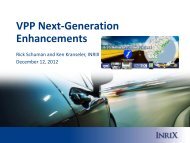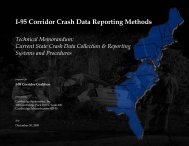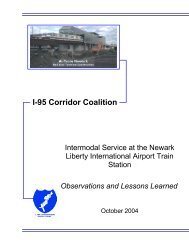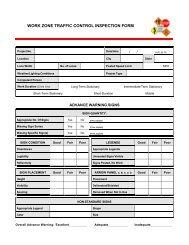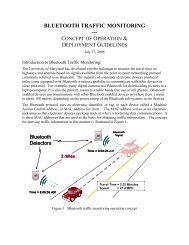View - I-95 Corridor Coalition
View - I-95 Corridor Coalition
View - I-95 Corridor Coalition
You also want an ePaper? Increase the reach of your titles
YUMPU automatically turns print PDFs into web optimized ePapers that Google loves.
I-<strong>95</strong> <strong>Corridor</strong> <strong>Coalition</strong><br />
AIRPORT OUTREACH<br />
AND INTERMODAL<br />
COORDINATION<br />
Final Report<br />
August 2003
AIRPORT OUTREACH AND<br />
INTERMODAL COORDINATION<br />
Final Report<br />
Prepared for:<br />
I-<strong>95</strong> <strong>Corridor</strong> <strong>Coalition</strong><br />
Sponsored by:<br />
I-<strong>95</strong> <strong>Corridor</strong> <strong>Coalition</strong><br />
Prepared by:<br />
Christine Cox, Noel Consulting, LLC<br />
Matthew Coogan<br />
August 2003<br />
1
FINAL REPORT- August, 2003<br />
I-<strong>95</strong> CORRIDOR COALITION<br />
INTERMODAL PROGRAM TRACK<br />
Airport Outreach and Intermodal Coordination<br />
Project Objective<br />
The overall project objective was to facilitate the participation of the airports in the Intermodal<br />
Program Track and develop ideas to improve intermodal connections at airports for both people<br />
and cargo. Other objectives are to:<br />
• build partnerships with aviation administrations/authorities, airports, and ground access<br />
providers;<br />
• identify intermodal issues, ITS needs, and solutions;<br />
• coordinate the implementation of intermodal freight and passenger initiatives; and<br />
• begin to develop a program and identify projects to improve access to airports for people and<br />
cargo.<br />
Task 1: Outreach Activities<br />
Objective. Engage the interest and participation of airport industry stakeholders in achieving the<br />
I-<strong>95</strong> <strong>Corridor</strong> <strong>Coalition</strong>’s goals.<br />
Completed:<br />
• Established an internal working group of volunteers interested in building an airport program as<br />
part of the <strong>Coalition</strong>’s Intermodal Program. (Membership turnover and lack of consistent<br />
response to requests for participation was an issue. A core group of <strong>Coalition</strong> members who<br />
would be advocates for airport issues is needed, however.)<br />
• Reviewed existing <strong>Coalition</strong> written material for its usefulness in initial airport outreach activities<br />
and recommended changes or additions to reflect intermodal activities that include airports,<br />
both in text and pictures.<br />
• Convened meetings of select stakeholders to gauge their interest in <strong>Coalition</strong> participation and<br />
to brainstorm project ideas and ways for a <strong>Coalition</strong> intermodal program to add value to airport<br />
operations. (A brief contact report on each meeting is appended to this summary.) Meetings<br />
included Airports International Council, airport management at BWI Airport, airport<br />
management at T.F. Greene (Providence, RI), and airport management at Raleigh-Durham<br />
Airport. Telephone outreach included staff at Airports International Council, staff at JFK Air<br />
Cargo Association, and consultant staff at Edwards & Kelcey interested in airport issues.<br />
Follow up contacts were also made with BWI Airport staff and RIDOT planning staff.<br />
2
Task 2: Development of Project Proposals<br />
Objective. Develop project proposals that can be sponsored and implemented by the participating<br />
<strong>Coalition</strong> members.<br />
Completed: General project ideas were incorporated in the White Paper prepared for the<br />
Intermodal Forum. Key points are excerpted below under Task 3. A specific project idea was<br />
prepared for developing an airport ground access module integrating airport information into the<br />
Intermodal Passenger Travel Information System. That project idea was considered in the Year 11<br />
program development process, and was moved forward by the Intermodal Program Track<br />
Committee first as a functional requirements definition project that could later become a specific<br />
deployment using a <strong>Coalition</strong> airport.<br />
Task 3: Provide input to the Intermodal Leadership Forum<br />
Objective. Prepare input material for the Intermodal Leadership Forum about the role of airport<br />
participation in achieving the <strong>Coalition</strong>’s goals.<br />
Completed: Through the information learned from the stakeholder outreach and from<br />
independent reading and research, a white paper was written as part of the input to the Intermodal<br />
Leadership Forum held in Arlington, Virginia in April, 2003. That paper is on the <strong>Coalition</strong> Web site,<br />
and is attached here.<br />
--- The following is excerpted from the white paper ---<br />
Future Activities and Recommended <strong>Coalition</strong> Role<br />
What has the <strong>Coalition</strong> learned and what’s next? Small steps have been taken to bring the air<br />
mode into the intermodal equation of the <strong>Coalition</strong> and to begin to nurture a relationship with the<br />
aviation community as part of the I-<strong>95</strong> <strong>Corridor</strong> <strong>Coalition</strong>’s intermodal program.<br />
Next steps for an airport focus in the <strong>Coalition</strong> program should be considered based not only upon<br />
learning from what has been done, but also from stepping back to assess what is needed, but is<br />
not likely to be undertaken by a single agency. And in the analysis, are there other intermodal<br />
activities underway by the <strong>Coalition</strong> not involving airports that could and should expand to the<br />
aviation community, building from work already accomplished?<br />
Three areas for a <strong>Coalition</strong> role are:<br />
• Operations coordination<br />
• Integration of air travel into trip itinerary planning and travel information systems<br />
• System capacity and utilization<br />
Operations Coordination. The <strong>Coalition</strong> provides organizational and technical support to foster<br />
learning and information sharing among <strong>Coalition</strong> member organizations and with others.<br />
Analyzing alternative approaches and sharing lessons learned is a natural near-term role for the<br />
<strong>Coalition</strong>. The <strong>Coalition</strong> also helps develop and manage information systems that assist agencies<br />
in system management and operation. That role has some longer term potential for the <strong>Coalition</strong><br />
as airport management and intermodal connections to air travel are further integrated. Some ideas<br />
for future initiatives:<br />
3
• The <strong>Coalition</strong> could provide a “roll up the sleeves and talk” forum for sharing experiences<br />
and lessons learned from those agencies that have already done significant intermodal<br />
access planning and operations. Discussions could include tips for developing and<br />
maintaining institutional relationships for planning and operating intermodal connections;<br />
planning for pre-trip and en route passenger information throughout the modal shifts;<br />
marketing to attract new customers; ground access information systems; electronic<br />
payment systems; baggage-friendly facilities, etc. The goal would be to bring the right<br />
people together with minimum structure and maximum round-table talk time.<br />
• The <strong>Coalition</strong> could support the networking and exchange of information among staff<br />
directly involved in planning and implementing intermodal facilities at airports. Identify the<br />
right people at agencies, what their role is and give them resources and support to mentor<br />
each other.<br />
• The <strong>Coalition</strong> could share results and lessons learned from the architecture development<br />
process and standards analysis to be completed for the passenger information systems<br />
serving NJTRANSIT and the Newark Liberty International Airport Rail Station. This could<br />
be very useful for other locations where multiple rail services will be linked.<br />
• The <strong>Coalition</strong> could demonstrate the feasibility and benefit of sharing real-time information<br />
about travel conditions on highways or transit with airport ground access operators, for<br />
benefit of the passenger who is renting a car, catching a train or for the operator of a<br />
bus/limo/taxi or shuttle.<br />
• The <strong>Coalition</strong> could support operations improvements to link transit schedules and<br />
operations more closely across multiple providers at the same location to facilitate the<br />
passengers’ choices and connections as they travel to or from an airport connection.<br />
• The <strong>Coalition</strong> could support activities, through both its Intermodal and Electronic Payment<br />
Services programs, to further the expansion of fare coordination and integration across air,<br />
transit, and rail modes.<br />
Trip Itinerary Planning and Travel Information Systems. The <strong>Coalition</strong> helps develop and improve<br />
passenger information systems to include intermodal trip planning and long-distance travel<br />
information. Information improvements that include intermodal access availability to airports will<br />
enable travelers to make more informed travel choices.<br />
Both through the Newark AirTrain project and discussions with airport operators, project<br />
participants have identified a lack of information across geographic, institutional and jurisdictional<br />
lines as a major problem in providing the passenger with ground access information needed to<br />
make trip decisions within a multi-state region. Customer Service Representatives who have been<br />
assisting passengers for 16 months at the Newark Liberty International Airport Rail Station are<br />
asked for assistance daily by passengers who are making train decisions to destinations in New<br />
York, Connecticut, New Jersey and Pennsylvania. There is no integrated resource available to<br />
them, nor is there such a resource available to the passenger as he/she plans the trip.<br />
The <strong>Coalition</strong> is currently participating in the development of intermodal passenger travel<br />
information systems. No one agency is going to integrate airport access information into a larger<br />
regional system. The <strong>Coalition</strong> is in a position to build upon work already underway and produce<br />
a unique tool for passengers and for agencies to use to assist passengers. A specific idea has<br />
emerged for consideration in the <strong>Coalition</strong>’s program development process:<br />
4
• Develop a prototype multi-region airport access module for an Intermodal Passenger Travel<br />
Information System.<br />
In addition, providing real time information about travel conditions on highways, transit, and other<br />
travel modes will also benefit the passengers who want to catch a train, bus, limo, taxi, or shuttle or<br />
rent a car. Another recommended future initiative for the <strong>Coalition</strong> is:<br />
• Explore ways to integrate and pass on real time information to the intermodal passenger.<br />
System Capacity and Utilization. Future directions could include: (points in italics were added<br />
since completion of white paper)<br />
• The <strong>Coalition</strong> could examine in greater depth the needs and issues of the “non-hub”<br />
airports in the <strong>Coalition</strong> region, and how intermodal solutions to passenger access might be<br />
improved. NCDOT suggested that several states that are dealing with the issue of barely<br />
surviving small commercial airports could develop consensus positions that would assist<br />
the state in dealing with local communities where these airports are located<br />
• Since the Intermodal Leadership Forum, a visit to the Raleigh-Durham Airport resulted in<br />
further input to project ideas. The idea of a small forum that would bring together airport<br />
operators to interact about “airports as intermodal hubs” was suggested. The focus would<br />
have to be practical, with sufficient draw to bring participants to share, and then to go back<br />
“home” with something valuable that is applicable at their own location. This forum would<br />
include both passenger and cargo issues.<br />
• The <strong>Coalition</strong> could conduct a study of the impact on passenger access to a mid-size<br />
airport when a discount carrier (e.g. Southwest or Jet Blue) began services that shifted<br />
passengers away from a major airport. Lessons learned would be for the benefit of other<br />
airports, transportation departments, and transit operators that could be affected by a<br />
similar shift.<br />
Many of the lessons learned by the partner agencies in the Newark AirTrain project will be<br />
invaluable to JFK Airport, to BWI Airport, and to the Rhode Island Airport Corporation as they<br />
deploy their intermodal centers that bring trains, rental cars, vans, buses and people-movers<br />
together for passengers to access their airport. Decisions that can affect future interoperability and<br />
exchange of information are often made a year or more before opening of a major capital<br />
construction. Some possible areas to explore further for future <strong>Coalition</strong> projects:<br />
• Assist with the operational deployment at the new Warwick Station or at BWI Airport,<br />
narrowing the focus to specific areas that meet the agencies’ needs, for example:<br />
– developing the system architecture for passenger information, or<br />
– developing, implementing and practicing procedures for interagency operational<br />
communication during emergencies or delays, or<br />
– assisting with the design, placement and integration of dynamic and static passenger<br />
information displays throughout the passenger flow in the modal shifts, or<br />
– facilitating interagency planning<br />
5
Summary and Conclusions<br />
Opportunities and challenges exist for the <strong>Coalition</strong> to work with members of the aviation<br />
community in the <strong>Coalition</strong> regions to integrate the needs of the airport operators with the<br />
programs of the <strong>Coalition</strong>.<br />
Based upon the use of air travel within the <strong>Corridor</strong> for long distance passenger trips, the increase<br />
in intermodal access to airports, the multi-state nature of the passenger market for the major<br />
airports, and the opportunity to build upon strengths of the <strong>Coalition</strong>’s current program, the<br />
following are recommendations to consider in determining future program direction:<br />
• Continue to build the relationships with airport managers and determine their needs, looking for<br />
opportunities for the <strong>Coalition</strong> to assist by leveraging resources, or adding value to multiagency<br />
efforts. Participation from airport managers in the core committee structure does not<br />
seem likely.<br />
• Assess opportunities to include airport and air travel issues in ongoing and future projects<br />
focusing on exchange of real time operational information, operations coordination (including<br />
fare and ticket integration), or system capacity and utilization.<br />
• Begin specific efforts to integrate airport access information into the Intermodal Passenger<br />
Information System.<br />
Final Observations and Next Step:<br />
Airport managers are slowly moving away from purely an airport-centric view, into more of a<br />
transportation system perspective. This change is more of a pragmatic adaptation than a visionary<br />
approach. Multi-modal access for passengers and cargo has become part of planning for future<br />
survival, competitiveness and growth. Although airport security is an issue, airport viability (airline<br />
viability) is more overriding, and airport access is a vital part of that viability.<br />
Airport passenger access issues and freight handling/air cargo issues have very different<br />
stakeholders and constituencies, although both are part of the whole transportation system. At a<br />
project level, the two areas of cargo and passenger will generate very different ideas.<br />
Airport managers are busy, focused people who want a return of value for investment of their time.<br />
Participation in the I-<strong>95</strong> <strong>Corridor</strong> <strong>Coalition</strong>’s committee structure, purely as an organization with<br />
admirable intermodal goals, is not likely. Participation in a specific project or information-sharing<br />
forum that brings direct benefit back to the organization on an issue or topic, or assists with a<br />
deployment or development of policy would draw interest.<br />
With the expansion of the <strong>Coalition</strong>’s membership geography to the full East Coast, continued<br />
outreach to more airports (especially the mid-sized and those about to undertake intermodal<br />
connections) is important for the intermodal agenda. The opportunity to add value will take shape<br />
through those discussions.<br />
Next Step: Organize and sponsor a forum about intermodal access at airports in the <strong>Corridor</strong>,<br />
showcasing some of the experiences that are in different phases of planning and deployment (JFK,<br />
BWI, Raleigh-Durham, for example.) Use the forum to “test the waters” for interest in some of the<br />
project directions mentioned above, such as operational coordination and traveler information.<br />
6
Airport Outreach Visit<br />
Location: Washington, D.C. Date: August 27, 2003<br />
Participants:<br />
Name Title/Agency info<br />
Stephen Van Beek<br />
Senior Vice President,<br />
svanbeek@aci-na.org<br />
Policy and Strategic<br />
Development, Airports Council<br />
International<br />
Chris Cox<br />
I-<strong>95</strong> <strong>Corridor</strong> <strong>Coalition</strong><br />
Matthew Coogan<br />
I-<strong>95</strong> <strong>Corridor</strong> <strong>Coalition</strong><br />
Highlights of Discussion:<br />
Coogan posed several questions. First, is the timing good or bad to be reaching out to Airports<br />
about ground access and the I-<strong>95</strong> <strong>Corridor</strong> <strong>Coalition</strong>’s intermodal program. Although ground<br />
access may not be the top priority of a specific airport, Steve indicated that capacity is always a<br />
concern; and environment and ground access are policy issues that he makes sure are on their<br />
policy plates.<br />
The ACI uses a committee system around policy issues, and Steve said that ACI could give policy<br />
“imprimatur” to the <strong>Coalition</strong>’s intermodal outreach. We asked if ACI would consider co-sponsoring<br />
an event that would bring some people together around these issues, and he was receptive to that<br />
idea.<br />
______________________________________________________________________________<br />
Airport Outreach Visit<br />
Location: BWI Airport Date: August 28, 2002<br />
Participants:<br />
Name Title/Agency info<br />
Paul Wiedefeld<br />
Executive Director,<br />
Maryland Aviation<br />
Administration<br />
Holly Collins<br />
Special Assistant to E.D,<br />
MAA<br />
pwiedefeld@mdot.state.md.us<br />
410-859-7060<br />
Hcollins1@bwiairport.com<br />
410-859-7534<br />
Lynn Bezilla,<br />
Simone C. Hall<br />
Chris Cox<br />
Matthew Coogan<br />
Director, Office of Facilities<br />
Planning,<br />
MAA<br />
Manager of Terminal<br />
Planning & Intermodal<br />
Development, MAA<br />
I-<strong>95</strong> <strong>Corridor</strong> <strong>Coalition</strong><br />
I-<strong>95</strong> <strong>Corridor</strong> <strong>Coalition</strong><br />
LBezilla@mdot.state.md.us<br />
410-859-7227<br />
Shall4@bwiairport.com<br />
410-859-7227<br />
7
Highlights of Discussion:<br />
The group discussed the evolution of Maryland’s focus on an expanded intermodal connection at<br />
BWI, including the consideration of remote baggage checking at Union Station DC.<br />
The Executive Director acknowledged that although security is a key issue, it is not so overriding<br />
that airport access and intermodal opportunities have to take a back seat. A conceptual plan for a<br />
Regional Intermodal Transportation Center is underway, and a feasibility study for a peoplemover<br />
was completed.<br />
The Director also expressed willingness to co-sponsor (and host) a forum with the <strong>Coalition</strong> that<br />
would bring together airport managers to focus on intermodal passenger connection issues.<br />
There was willingness to participate with the <strong>Coalition</strong> on specific issues or events that would have<br />
value to BWI.<br />
__________________________________________________________________________<br />
Airport Outreach Visit<br />
Location: T.F. Green Airport (PVD), Warwick, RI Date: January 16, 2003<br />
Participants:<br />
Name Title/Agency info<br />
Mary Soderstrum<br />
Deputy Executive Director,<br />
Engineering and Planning,<br />
Rhode Island Airport<br />
Corporation<br />
Paul Silva<br />
Chris Cox<br />
Matthew Coogan<br />
Principal Planner, State of<br />
Rhode Island<br />
Department of<br />
Transportation, Intermodal<br />
Planning<br />
I-<strong>95</strong> <strong>Corridor</strong> <strong>Coalition</strong><br />
I-<strong>95</strong> <strong>Corridor</strong> <strong>Coalition</strong><br />
MSoderstrum@pvdairport.com<br />
401-737-4000<br />
psilva@dot.state.ri.us<br />
401-222-4203, ext. 4231<br />
(retiring in 2003)<br />
Others contacted in the process of setting up the meeting: Chuck Alves at RIDOT and Steve<br />
Devine at RIDOT. Chuck had been promoted to the Secretary’s Office, so Steve followed up the<br />
contact. Paul Silva was assigned to attend the meeting, and he brought details about the status of<br />
the intermodal station with him.<br />
Highlights of Discussion with Airport Director:<br />
At the time of the Administration change in early 2003, a new Warwick train station was planned for<br />
construction as an Amtrak stop, and as a stop for MBTA extension from Massachusetts down to<br />
Providence and South Kingston. The station will be ¼ mile from the airport.<br />
8
If fully developed as planned, the intermodal station would consist of a parking garage/rental car<br />
mall; a train station & platforms; and an automated people mover linking rail passengers, rental car<br />
users and parking users to/from the airport.<br />
The future of the full intermodal station was on hold at the time of the meeting. If the station<br />
proceeds as planned, Mary Soderstrum expressed interest in learning more specifically from the<br />
experience at Newark in the deployment of the AirTrain to link passengers to/from the airport and<br />
the new train station.<br />
When asked what she needed to help in the development of this intermodal link, she responded<br />
that it is difficult to know what percentage of airport traffic would come by rail, and others<br />
experiences with that from other <strong>Coalition</strong> members would be helpful to know about.<br />
There was no discussion of cargo activities.<br />
Other comments: It may prove useful to contact Vince Scarano at FAA, who is coordinating a New<br />
England regional airport plan. Other contact ideas: Consultant Brian Racoff at Lewis Berger<br />
who is working on the regional airport plan. The New England airports work together on this plan;<br />
maybe that’s an opportunity for the <strong>Coalition</strong> to interact with them as a group.<br />
______________________________________________________________________________<br />
Airport Outreach Visit<br />
Location: Raleigh-Durham Airport Date: July 17, 2003<br />
Participants:<br />
Name Title/Agency info<br />
John Brantley<br />
(first meeting only)<br />
Airport Director, RDU<br />
Airport Authority<br />
David King<br />
Deputy Secretary for<br />
Transit, NCDOT<br />
ddking@dot.state.nc.us<br />
9190733-2520<br />
Bill Williams<br />
Director of Aviation,<br />
NCDOT<br />
wwilliams@dot.state.nc.us<br />
Chris Cox<br />
Matthew Coogan<br />
Ted Alman<br />
(second meeting only)<br />
I-<strong>95</strong> <strong>Corridor</strong> <strong>Coalition</strong><br />
I-<strong>95</strong> <strong>Corridor</strong> <strong>Coalition</strong><br />
Special Projects Manager,<br />
NCDOT, Div. of Aviation<br />
919-840-0112<br />
talman@dot.state.nc.us<br />
Highlights of Discussion with Airport Director:<br />
Cox/Coogan gave brief overview of <strong>Coalition</strong> history and reason for this project – to talk to Airport<br />
management about how the Aviation mode could become more a part of the <strong>Coalition</strong>’s intermodal<br />
“table.”<br />
The Airport Director talked generally about cargo intermodal connections, giving some local<br />
examples, as well as pointing to successful air-rail-truck intermodal facilities in Huntsville, Alabama<br />
9
and in Texas. His opinion is that cargo growth is truck-centered, with airports becoming more of a<br />
transfer point.<br />
More input from Director Brantley:<br />
FedEx is planning a major facility at Greensboro for an air-truck connection.<br />
At Raleigh-Durham, there has been growth in shipping cargo in the belly of passenger planes –<br />
example of United flights to London. At Charlotte, a Norfolk-Western yard is being moved to the<br />
airport.<br />
At the intermediate size airports that are not in a densely populated area, it is much more difficult to<br />
develop economically feasible air-rail links whose ridership justifies the investment to build. That<br />
situation exists with the Research Triangle area and the Raleigh-Durham Airport. Negotiations<br />
with Amtrak are underway for a station stop at Research Triangle Park which is about 2 miles<br />
away. Some kind of (shuttle) link from there to the Airport would be a logical next step. At some<br />
time in the future there will be transit connection at RDU.<br />
The Director commented that the U.S. is moving toward more of a European model of an<br />
integrated system of transportation…and that Airports have to be a part of that model. It wasn’t<br />
always that way in the U.S.<br />
With airline service consolidation increasing, ground access to outlying areas will be more<br />
important. (RDU is growing to over 20,000 parking spaces.)<br />
In NC, the airport has the potential to be the draw for the integrated system hub. RDU is close to a<br />
rail line, but the dollars to get rail into the airport aren’t there. Some companies may cluster near<br />
the airport and bring the rail along with them.<br />
“Airports have to become better servants to passengers & freight.”<br />
We have to make better use of what we have (the infrastructure). Larger airports have to become<br />
multi-modal centers because of the limit of land.<br />
With freight, there has been fluctuation with the economy and national events. Incoming freight to<br />
RDU is stable; outgoing is down.<br />
RDU will be a center of commerce; it’s going to happen and we have to optimize the transition.<br />
RDU has grown from 47% to 52% of the airport origin/destination usage in North Carolina<br />
__________<br />
The question was asked of the Airport Director – where do you find like-minded folks who think<br />
about the wider vision of an integrated system?<br />
Response - in an academic setting like the Center for University Transportation Research;<br />
At TRB, there is more of an Aviation presence than at other associations.<br />
The full integrated system approach can’t have a bias that is modal or political.<br />
Have to have a forum that’s not biased, where people can get thinking reasonably together; not in<br />
a grant-giving environment either; need a forum for true debating of a more academic nature.<br />
10
__________<br />
The conversation shifted briefly to issues of small airports/smaller communities and their<br />
desperation to keep airports functioning when it’s not necessarily feasible to do so. Is there really<br />
a future role for short-hop commuter links to airports like RDU?<br />
David King expressed the desire to have the strength of consensus from other states’ experiences<br />
to go to small communities with viable alternatives to keeping the airports operating. Small<br />
communities need consensus answers. [Is there a <strong>Coalition</strong> role here?]<br />
David King suggested a <strong>Coalition</strong> activity:<br />
Conduct an issue-driven forum. Pick and choose issues(s) such as small airports/communities. Or<br />
get a half dozen airport operators from a half dozen states to “debate” the airport as intermodal<br />
center; bring back ideas that are helpful to all who participated and to those who didn’t.<br />
If the <strong>Coalition</strong> does something, it has to be valuable to the participants. Airport operators are very<br />
busy and could go to a meeting/conference every day if they wanted to. The best use of their time<br />
is to go to an event where they “Find out best practice, share it, go back and practice it.” Don’t do<br />
something that isn’t helpful.<br />
__________<br />
At a follow up meeting with David King and Ted Alman at the Aviation building, they shared<br />
information about North Carolina DOT’s study of Commercial Air Service in the state. The data<br />
was later used to develop an application to USDOT on behalf of a consortium of 6 small<br />
communities and their airports for a grant that would support marketing and outreach activities,<br />
funded through the Small Community Air Service Development Pilot Program at USDOT. That<br />
application was just submitted.<br />
In the past, airports have applied directly. It is atypical for a state, acting on behalf of a consortium<br />
of small airports, to be the applicant.<br />
______________________________________________________________________________<br />
Airport Outreach – telephone contacts<br />
Name Title/Agency Info<br />
Dick Marchi<br />
Airports Council<br />
International,<br />
Capacity & infrastructure<br />
202-293-8500,<br />
RMarchi@aci-na.org<br />
Jim Larsen JFK Air Cargo Assoc. Jfkaircargo.com,<br />
1-845-528-4453<br />
Richard Horstmann Edwards & Kelsey 610-701-7000,<br />
rhorstmann@ekmail.com<br />
11
Highlights from conversations:<br />
Marchi – Airport managers are not intermodally enlightened, except maybe where there are air<br />
quality problems. In general, driving is still expected. Some intermodal centers are growing from<br />
consolidated auto rental facilities; there is a trend to move rental cars remotely together. Re: air<br />
freight – A freight mover makes a tactical choice to move freight by truck to the best airport. There<br />
is competition among modes for funding opportunities. There is an educational need about funding<br />
in other modes. Misconception is that surface mode people are trying to steal money from other<br />
modes. The <strong>Coalition</strong> could provide a forum for best practices around customer issues at<br />
intermodal links. “Most surface access thinking is not good analysis.”<br />
Larsen – opportunities exist in the air cargo arena for coordination, cooperation, data-exchange,<br />
advocacy & leadership; operations & safety coordination. Issues of technology and liability are<br />
important. Emergency back-up planning for water-bound airports is important, such as the use of<br />
ferries as links for cargo.<br />
Horstmann – drawing from previous airport experience, and knowing the impact that a discount<br />
carrier has on the use of an airport, suggest that the <strong>Coalition</strong> consider a study of the potential<br />
shifts in usage, and the transportation system impacts from a Jet Blue or Southwest Airlines<br />
locating at one of the regional airports.<br />
12



